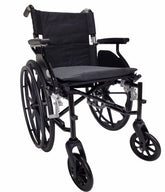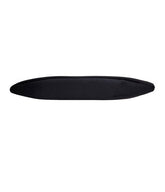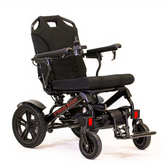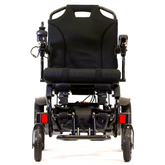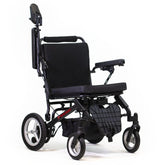Guide to Compression Socks
21 Aug 2023
Compression socks have become increasingly popular as a go-to solution for leg health and improved circulation. Whether you're an athlete, frequent traveler, or someone looking to alleviate leg discomfort, understanding compression socks is essential. In this comprehensive guide, we will explore the benefits, types, and usage tips of compression socks to help you make an informed decision about incorporating them into your daily routine.
1. What are Compression Socks?
Compression socks are specialized garments designed to provide graduated pressure to the legs, ankles, and feet. Unlike regular socks, they exert the highest pressure at the ankle and gradually decrease as they move up the leg. The compression helps promote blood flow, reduce swelling, and alleviate leg pain and fatigue.
2. Benefits of Compression Socks:
Compression socks offer a multitude of benefits, making them suitable for various individuals and lifestyles. Here are some key advantages:
- Improved Circulation: By applying gentle pressure to the legs, compression socks aid in blood circulation, preventing blood pooling and promoting oxygen and nutrient delivery to the muscles.
- Reduced Swelling: Compression socks can effectively reduce edema and swelling in the legs and ankles, making them beneficial for individuals who spend long hours on their feet or suffer from conditions like varicose veins or lymphedema.
- Increased Performance and Recovery: Athletes often wear compression socks to enhance performance and facilitate post-workout recovery. The compression helps reduce muscle vibration, fatigue, and soreness.
- Travel Comfort: Compression socks are highly recommended during long flights or road trips to minimize the risk of deep vein thrombosis (DVT) and relieve leg discomfort associated with prolonged sitting.
- Pregnancy Support: Pregnant women often experience leg swelling and varicose veins. Compression socks can provide relief by improving circulation and reducing fluid retention.
3. Types of Compression Socks:
Compression socks come in various styles and compression levels to accommodate different needs. Here are the most common types:
- Knee-High: Knee-high compression socks cover the lower leg and end just below the knee. They are versatile and suitable for everyday wear, providing support for individuals with mild to moderate leg conditions or those seeking preventive measures.
- Thigh-High: Thigh-high compression socks extend up to the mid-thigh region, offering greater coverage and support. They are commonly used for more severe leg conditions or post-surgical recovery.
- Open-Toe: Open-toe compression socks have a cutout at the toe area, allowing for ventilation and making them suitable for individuals who prefer wearing their own socks or have foot conditions that require uncovered toes.
4. Choosing the Right Compression Level:
Compression socks are available in different compression levels, measured in millimeters of mercury (mmHg). The appropriate compression level depends on your specific needs, and it is advisable to consult with a healthcare professional for personalized recommendations. The most common compression levels include:
- Mild (8-15 mmHg): Suitable for preventive measures, mild swelling, and general leg discomfort.
- Moderate (15-20 mmHg): Ideal for individuals with mild to moderate leg pain, varicose veins, or during pregnancy.
- Firm (20-30 mmHg): Recommended for moderate to severe leg conditions, post-surgical recovery, and athletic performance.
- Extra Firm (30-40 mmHg): Reserved for severe leg conditions and prescribed by healthcare professionals.
5. Usage Tips for Compression Socks:
To optimize the benefits of compression socks, consider the following tips:
- Wear them consistently: For maximum effectiveness, wear compression socks regularly, especially during activities that involve prolonged sitting, standing, or physical exertion.
- Put them on properly: Take your time while putting on compression socks to ensure a smooth and even fit. Avoid bunching or folding, as it can create pressure points and discomfort.
- Follow manufacturer's instructions: Each brand may have specific care instructions for their compression socks. Follow these guidelines to maintain their quality and longevity.
- Replace as needed: Over time, compression socks may lose their elasticity and effectiveness. Replace them when they no longer provide the desired level of compression or show signs of wear and tear.
Conclusion:
Compression socks offer a range of benefits, from improved circulation and reduced swelling to enhanced performance and recovery. By understanding the types, benefits, and compression levels, you can make an informed choice when selecting compression socks that suit your specific needs. Embrace the comfort, support, and leg health benefits that compression socks provide, and enjoy the advantages they offer in various aspects of your life.
1. What are Compression Socks?
Compression socks are specialized garments designed to provide graduated pressure to the legs, ankles, and feet. Unlike regular socks, they exert the highest pressure at the ankle and gradually decrease as they move up the leg. The compression helps promote blood flow, reduce swelling, and alleviate leg pain and fatigue.
2. Benefits of Compression Socks:
Compression socks offer a multitude of benefits, making them suitable for various individuals and lifestyles. Here are some key advantages:
- Improved Circulation: By applying gentle pressure to the legs, compression socks aid in blood circulation, preventing blood pooling and promoting oxygen and nutrient delivery to the muscles.
- Reduced Swelling: Compression socks can effectively reduce edema and swelling in the legs and ankles, making them beneficial for individuals who spend long hours on their feet or suffer from conditions like varicose veins or lymphedema.
- Increased Performance and Recovery: Athletes often wear compression socks to enhance performance and facilitate post-workout recovery. The compression helps reduce muscle vibration, fatigue, and soreness.
- Travel Comfort: Compression socks are highly recommended during long flights or road trips to minimize the risk of deep vein thrombosis (DVT) and relieve leg discomfort associated with prolonged sitting.
- Pregnancy Support: Pregnant women often experience leg swelling and varicose veins. Compression socks can provide relief by improving circulation and reducing fluid retention.
3. Types of Compression Socks:
Compression socks come in various styles and compression levels to accommodate different needs. Here are the most common types:
- Knee-High: Knee-high compression socks cover the lower leg and end just below the knee. They are versatile and suitable for everyday wear, providing support for individuals with mild to moderate leg conditions or those seeking preventive measures.
- Thigh-High: Thigh-high compression socks extend up to the mid-thigh region, offering greater coverage and support. They are commonly used for more severe leg conditions or post-surgical recovery.
- Open-Toe: Open-toe compression socks have a cutout at the toe area, allowing for ventilation and making them suitable for individuals who prefer wearing their own socks or have foot conditions that require uncovered toes.
4. Choosing the Right Compression Level:
Compression socks are available in different compression levels, measured in millimeters of mercury (mmHg). The appropriate compression level depends on your specific needs, and it is advisable to consult with a healthcare professional for personalized recommendations. The most common compression levels include:
- Mild (8-15 mmHg): Suitable for preventive measures, mild swelling, and general leg discomfort.
- Moderate (15-20 mmHg): Ideal for individuals with mild to moderate leg pain, varicose veins, or during pregnancy.
- Firm (20-30 mmHg): Recommended for moderate to severe leg conditions, post-surgical recovery, and athletic performance.
- Extra Firm (30-40 mmHg): Reserved for severe leg conditions and prescribed by healthcare professionals.
5. Usage Tips for Compression Socks:
To optimize the benefits of compression socks, consider the following tips:
- Wear them consistently: For maximum effectiveness, wear compression socks regularly, especially during activities that involve prolonged sitting, standing, or physical exertion.
- Put them on properly: Take your time while putting on compression socks to ensure a smooth and even fit. Avoid bunching or folding, as it can create pressure points and discomfort.
- Follow manufacturer's instructions: Each brand may have specific care instructions for their compression socks. Follow these guidelines to maintain their quality and longevity.
- Replace as needed: Over time, compression socks may lose their elasticity and effectiveness. Replace them when they no longer provide the desired level of compression or show signs of wear and tear.
Conclusion:
Compression socks offer a range of benefits, from improved circulation and reduced swelling to enhanced performance and recovery. By understanding the types, benefits, and compression levels, you can make an informed choice when selecting compression socks that suit your specific needs. Embrace the comfort, support, and leg health benefits that compression socks provide, and enjoy the advantages they offer in various aspects of your life.
